Following a disappointing end to Unai Emery’s first year at the helm, it’s clear that significant improvements are needed at Arsenal. However, with limited finances, giving opportunities to some of their emerging youth products is likely to play an important part in their attempts to rejoin Europe’s elite.
Along with blooding youngsters such as Reiss Nelson, Joe Willock, and Emile Smith-Rowe, head coach Unai Emery might also look to give Alex Iwobi a more integral role in the side. The 23-year-old hasn’t been without his critics since breaking into the first-team back in 2015. However, there were plenty of positives to take from his contributions last term.
In this tactical analysis, we will examine the 23-year-old’s strengths, while highlighting some room for improvement.
Chance creation
Although Arsenal’s goals tally was just one lower than in Arsene Wenger’s final campaign, they finished last season with only the 11th most attempts on goal. Their shot total of 467 was down 127 from the previous term. Furthermore, their highest assist provider was Alexandre Lacazette with eight, the lowest among the top six teams. Mesut Ozil was expected to shoulder much of the responsibility for chance creation, but the former Germany international only recorded two assists in 25 domestic appearances.
Arsenal’s creativity problems have been further compounded by the departure of Aaron Ramsey to Juventus, while Henrikh Mkhitaryan is yet to perform consistently. Dani Ceballos has been linked with a loan move from Real Madrid, but the Spaniard failed to register an assist in 1,324 La Liga minutes, scoring on three occasions. His ability to progress the play with dribbling would be a welcome addition, but there’s little indication that he could solve the Gunner’s problems in midfield.
Part of the solution may come in the form of academy graduate Alex Iwobi. The Nigerian international made 22 starts in the league during Emery’s first year in charge, operating primarily on the left wing in his tactics. Despite being in and out of the side, he managed to finish in the Premier League’s top 20 for ‘big chances created’, registering a total of 10. He also recorded eight assists in all competitions (0.24 per 90). For comparison, Ozil created 3 big chances in the league, completing 0.11 assists on average.
The image below illustrates Iwobi’s final assist of the season, coming against Burnley at Turf Moor. Having received on the left side of the penalty area, he quickly scans the options available to him before picking out Aubameyang at the back post. Given the congested nature of the play, it was an excellent display of spatial awareness and vision.
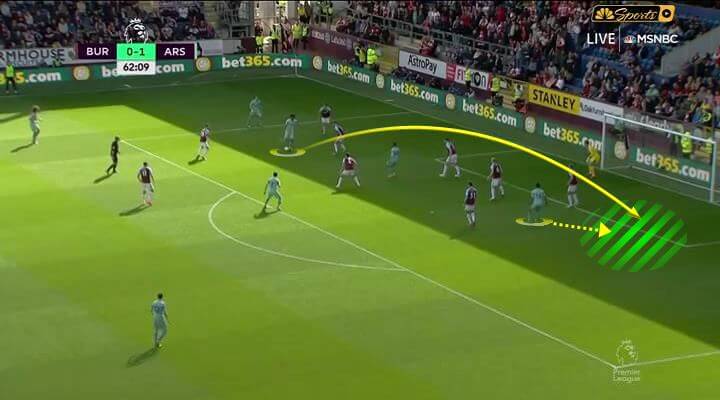
These types of actions are a common feature of his game, regularly receiving possession on the advanced left-wing before looking for movement in the box. The next image provides another example.
On this occasion, Lacazette and Aubameyang are both occupied by defenders. A small gap exists in the centre, triggering Granit Xhaka to make a late move forward. Iwobi spots his run and finds him with a perfectly weighted chip before the Swiss midfielder finishes to give Arsenal the lead.
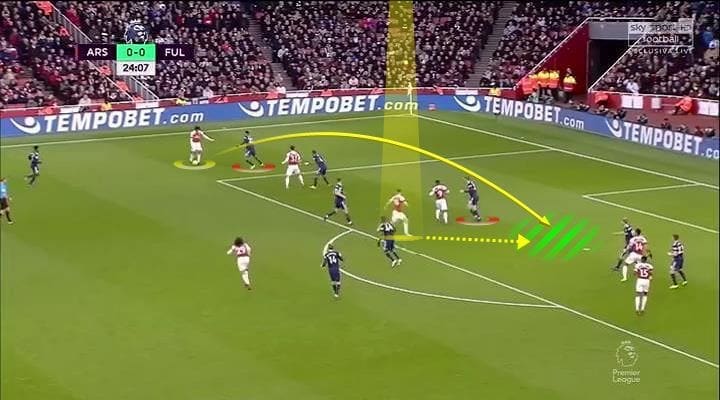
While lofted passes into the area formed an important part of his chance creation, he also excelled in more typical crossing scenarios. Rather than always looking to cut inside onto his stronger foot, Iwobi was often able to dribble down the line before looking for a teammate in the box with a driven low-cross.
The examples below provide evidence of this ability. In the first scene, he bypasses Georginio Wijnaldum to create a crossing opportunity. After dribbling past the Dutch midfielder with ease, he finds Ainsley Maitland-Niles at the far post. As with each of the assists shown so far, the eventual goalscorer is behind multiple defensive cover shadows, making the delivery even more impressive.
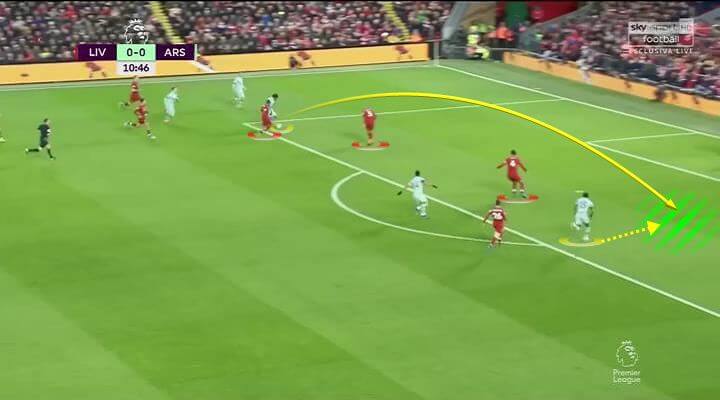
The moment seen above shows that Iwobi can beat defenders in one v one situations out wide with quick changes of direction and ball manipulation. His capacity to find the best option in the box is also notable, and his cross accuracy stands at 35.6%. To put this number into context, Wilfried Zaha finds a teammate with 38% of his crosses, while Ryan Fraser has a success rate of 37.9%.
The next example reiterates his crossing ability, picking out Lacazette with a low and hard delivery towards the near post. The execution needed to be perfect yet again, with the passing lane restricted by the defender’s positioning.
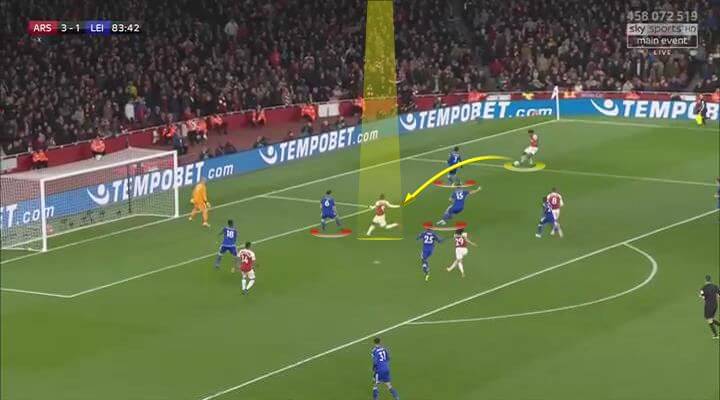
Evidently, he can offer a lot coming from wide areas. However, there are many reasons to believe that moving to a more central role could see him take his game to the next level. On the international stage, Iwobi regularly lines up as a number 10, while he has also enjoyed fleeting spells in this position at club level.
With less space to work with, his close control, speed of thought and press resistance are tested more when playing through the middle. As of yet, he hasn’t struggled to overcome these challenges. Arsene Wenger made note of these attributes when discussing his potential as a 20-year-old.
“Alex is always quick connecting with other players, at a very high level and a very high pace. Football is perception, decision-making, and acting. The perception he has of the game especially struck me, and the speed of his decision-making.”
The image below is taken from his substitute appearance at home against Liverpool and highlights his ability to create from central positions. After moving infield, he spots the movement of Lacazette on the shoulder of Joe Gomez. Despite the narrow spacing between the Red’s midfielders, a large gap exists between the right-back and the centre-back. A well executed through ball follows from Iwobi, leading to an equalising goal.
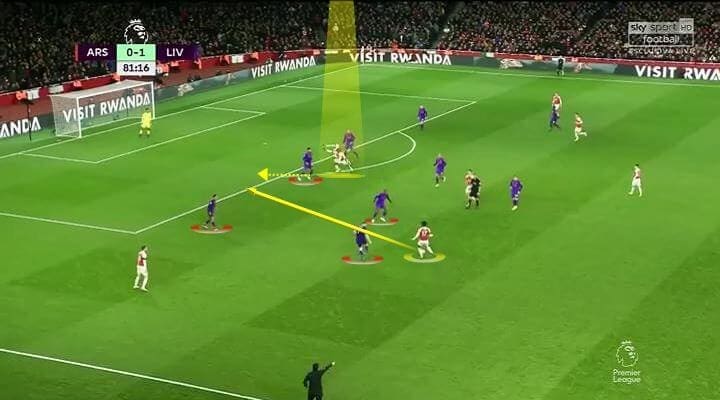
As mentioned, a number 10 will often be required to take possession in tight spaces, where multiple opponents can apply pressure from different angles. Along with having the quick feet needed to navigate these scenarios, Iwobi also has the physical strength to hold off defenders.
In the sequence below, the former England youth player receives in the ten space from Xhaka. Three Bate Borisov midfielders look to collapse in on the space surrounding him in the hope of completing a turnover.
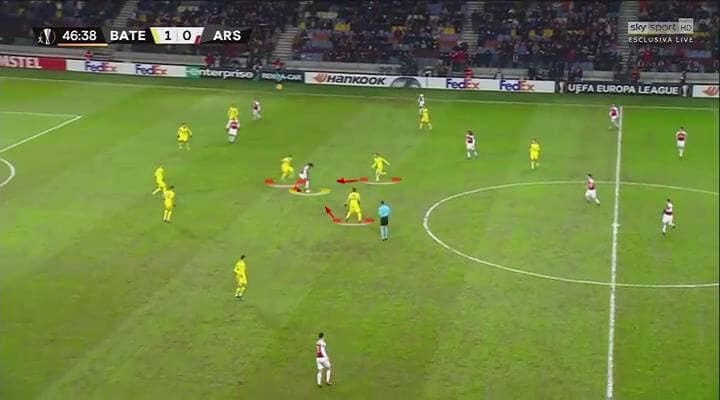
He manages to shield the ball before exiting the pressure and exploiting the open space. Noticing the run of Sead Kolasianac in behind the Bate defensive line, he plays the left-back through with a penetrative pass. The Bosnian’s cross is ultimately blocked, but the move illustrates Iwobi’s ability to cope in central areas.
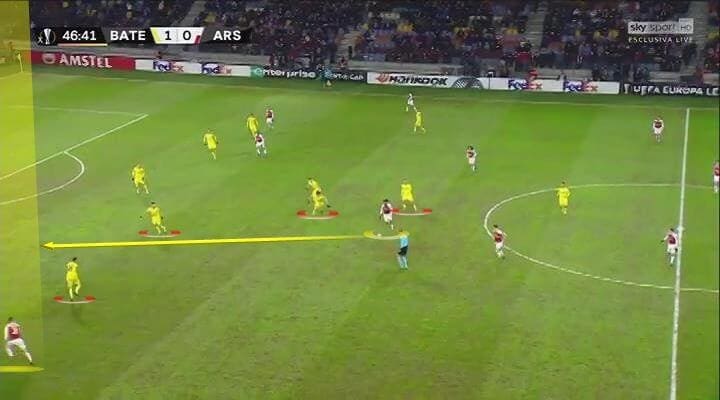
Whether he starts on the flanks or further infield, it’s clear that Iwobi has the necessary qualities to provide his team with a productive outlet when it comes to chance creation.
In the Premier League last season, 1.82 of his passes per game resulted in shots, bettering Paul Pogba’s average of 1.64. He also recorded 0.35 ‘expected assists’ per 90, the same number as Eden Hazard and considerably higher than both Pogba(0.15) and Christian Eriksen(0.26). His average assists stat was 0.27, matching Pogba while falling lower than Hazard and Eriksen.
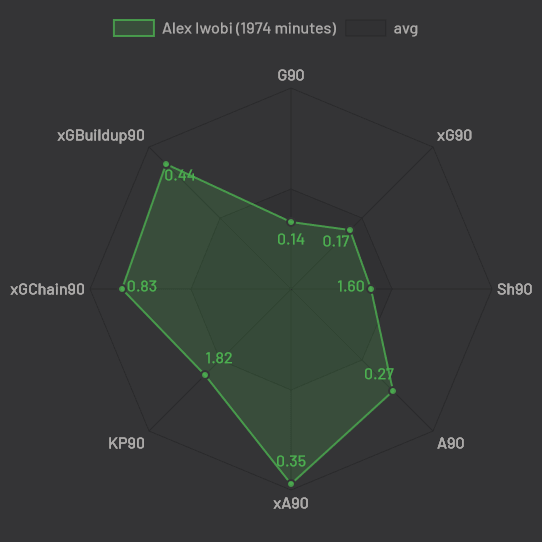
Overall, Iwobi’s chance creation numbers were among the best in the league last term. Should he earn a more regular starting place under Emery in the next campaign, it will be interesting to see if he can maintain that record from week to week.
Progressive dribbling
As we touched upon earlier, making the most of his creative talents might involve a slight change in position. Arsenal are relatively well-stocked at the base of midfield, with Xhaka, Lucas Torreira, and Matteo Guendouzi all competing for the pivot roles. Given the loss of the Ramsey and the lack of consistency from Ozil and Mkhitaryan, there exists a significant void between the midfield and the attack that must be filled.
Traditional number 10’s have become less common in recent years, with so many team’s preferring to play with two ‘offensive number 8’s’ and a number 6. The likes of Kevin de Bruyne and David Silva at Manchester City have been expected to vary their game between playing off the front and dropping short to engage in build-up.
Iwobi’s vision makes him well suited to playing in a central role, while his ability to progress the play with a dribble also indicates potential to play as a number 8. Since the departures of Alex Oxlade-Chamberlain and Jack Wilshere, the Gunners have lacked a midfielder that can drive forward with the ball.
Making progressive dribbles to carry his team forward is a quality that has been evident in Iwobi’s game ever since his breakthrough in 2016. However, these abilities have mostly been confined to the wings. Based on his physical profile and close control, he may be better placed in an inside left position.
From there, he can offer his creative talents in the final third, while also coming deep to support build-up play and dribble through the opponent’s midfield line. Last season saw the Super Eagles star make 6.66 dribbles per game, succeeding 66.7% of the time. Aaron Ramsey averaged 3.25, while Xhaka, Torreira, and Guendouzi each failed to attempt more than 2.5 dribbles per 90. The aforementioned trio are primarily focused on making progressive passes, so adding a progressive dribbler in central areas would provide a much-needed extra dimension.
Iwobi made 3.4 progressive runs per game, which involve moving the ball forwards by 10 or more metres. This number compares favourably with Pogba’s 1.63, as well as Tottenham Hotspur’s new singing, Tonguy Ndombele(1.67). During their respective final season’s in North-London, Oxlade-Chamberlain and Wilshere both failed to score higher than 2.5 for this metric.
The analysis images below illustrates his ability to bypass multiple opponents with the ball at his feet, with Everton’s Idrissa Gueye and Seamus Coleman moving out to close the wide-man down. Lacazette trusts his teammates’ talents in this department, moving towards the box to free up space.
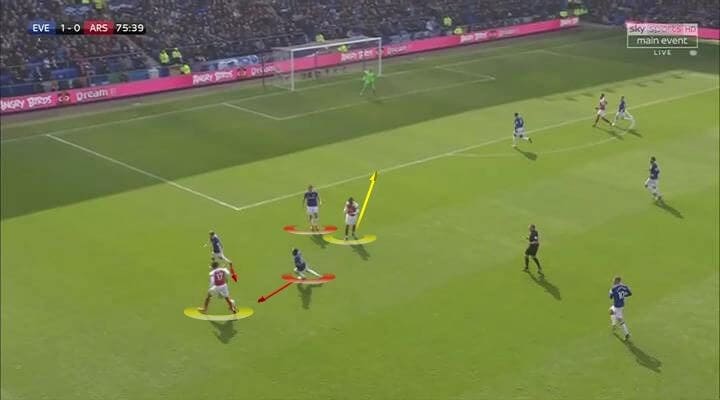
Iwobi shifts the defenders enough to create a gap between them, before carrying the ball through and feeding Lacazette in behind the opposition’s last line. While this example shows a scenario that plays out on the flank, the skills highlighted are transferable to central areas. Space was limited, and he didn’t simply rely on pace to get beyond the defenders. Instead, he needed to make use of close control and an awareness of where space existed.
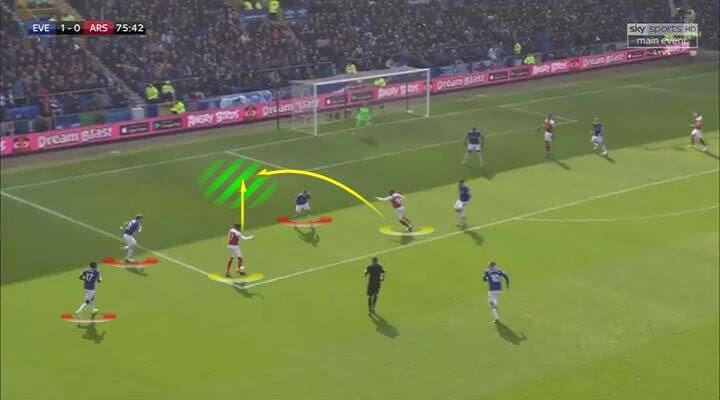
The next sequence illustrates these qualities once more. Having received possession with his back to goal in the left half-space, Iwobi has two Bate players approaching him from different angles. He recognises the space infield, shifting his marker with a false movement towards the wing.
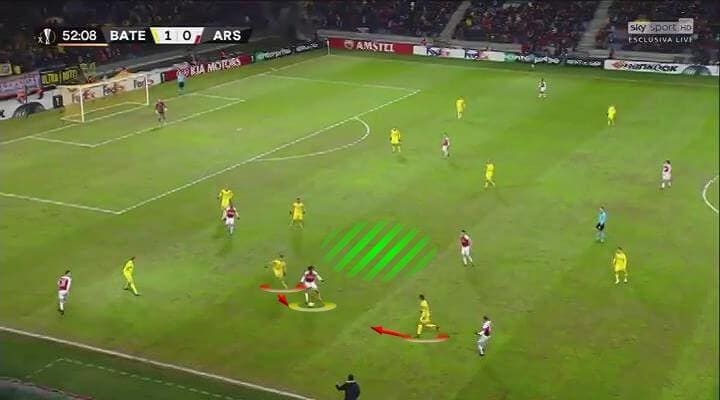
As he carries the ball towards the centre, a second opponent moves into a covering position. Iwobi quickly adjusts to the changing circumstances, instead dribbling into space directly in front of him.
His teammates move inside to drag the defenders away from the space, allowing him to drive down the touchline and provide a cross. The delivery is ultimately blocked, but the sequence shows his ability to take the ball in tight spaces and still find a way to progress the play.
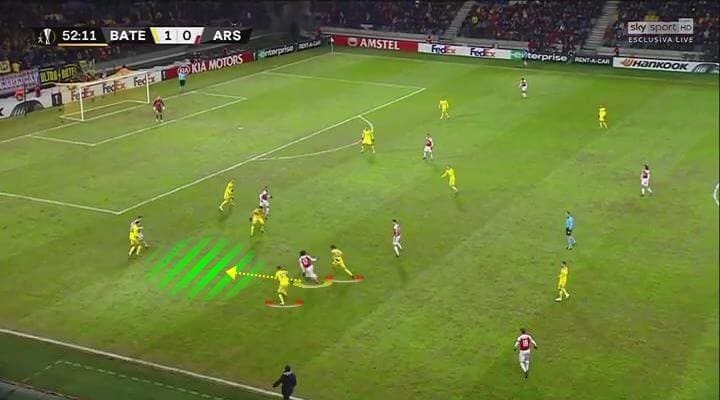
As we have seen in this analysis, Iwobi has the ability to serve his team’s attack in multiple ways. His vision allows him to identify when a teammate is free to receive in the final third, while his close control and physical strength aid him in dribbling scenarios, both out wide and in central areas. Despite recently stating his willingness to play anywhere the coach asks him to, he did hint that a move towards the middle would be welcome.
“Growing up I’ve been playing as an attacking midfielder, more central in the midfield. I wouldn’t say if I’m most comfortable there but that’s where I grew up playing.
Pressing and recoveries
Along with his offensive talents, Iwobi also contributes significantly during the defensive phases. His committed approach often sees him making energetic recovery runs to support the defence in moments of transition. Furthermore, he consistently applies intense pressure during the opposition’s build-up play.
Over the course of last season, he made an average of 3.37 recoveries per 90, 63.2% of which came in the opponent’s half. While this isn’t a particularly strong stat, it would likely improve greatly were he to play in the centre and in a slightly deeper role. Guendouzi, for example, recovered the ball 7.84 times per game, but only 39.9% of those dispossessions occurred in the opposition’s half.
The sequence below shows an example of Iwobi regaining possession for his side during a West Ham United counter-attack. The Hammers drive forward at speed to create a 4v4 in the attack. Iwobi chases back, making up significant ground on Wilshere.
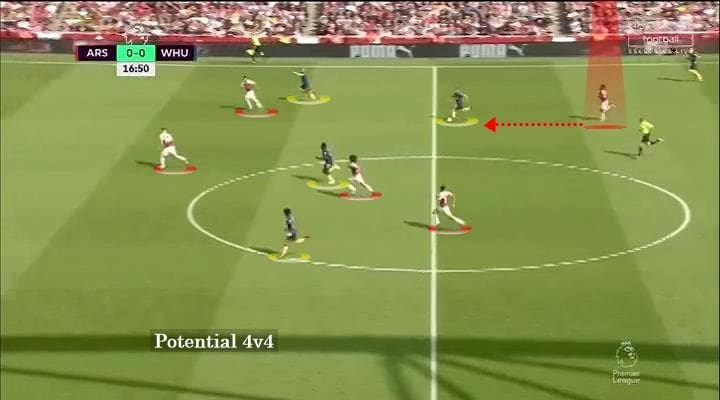
Felipe Anderson had become free on the far side, but Iwobi is able to catch up with the player on the ball. He completes a well-timed challenge, allowing Arsenal to mount a counter of their own with space to exploit.
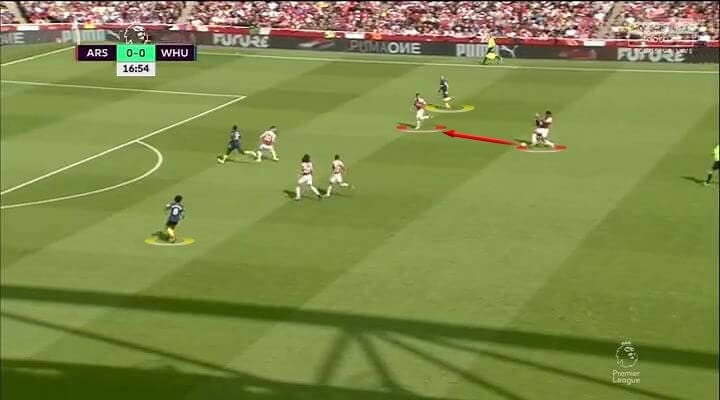
Last summer, an image emerged detailing Arsenal’s quickest players. The outfield members of the first-team squad were tested on their maximum speed, with Iwobi ranking in 4th. Meanwhile, deep-lying midfielders Xhaka, Torreira, Guendouzi, and Elneny made up the bottom four.
The next example shows him covering for a teammate’s lack of pace, again during a West Ham break away. With Guendouzi struggling to keep up with the opponent’s counter, Iwobi sprints back to stop Michail Antonio in his tracks.
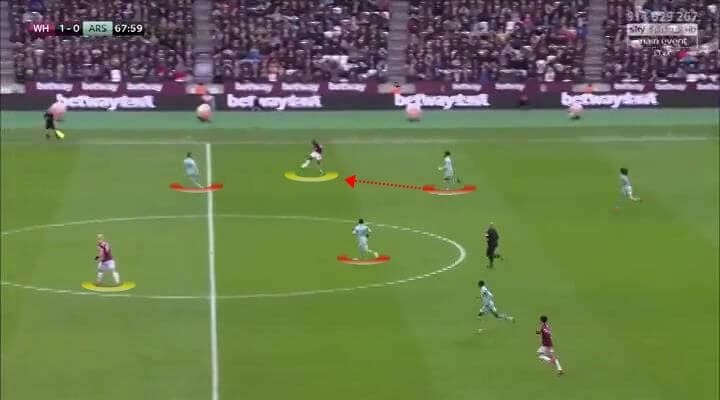
He recovers the ball before driving forward into space. His technical and physical profiles support him in attacking transitions, but also allow him to aid the team in disorganised moments out of possession. The example shown captures this perfectly, with Iwobi preventing a counter-attack at one end before leading a breakaway at the other.
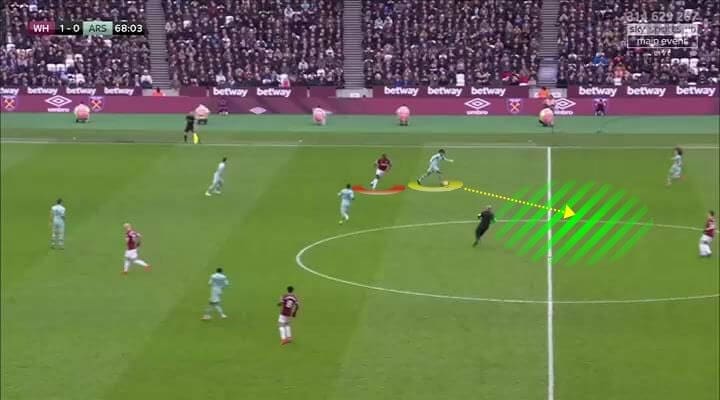
As mentioned previously, he also offers support during the different phases of pressing. Emery has tried to implement a more efficient model of applying pressure to the opposition, with more coordination than previously seen at the Emirates.
The Spanish coach wants his attackers to defend from the front, closing off the immediate options to the ball-occupant and forcing misplaced passes. Aubameyang and Lacazette have been crucial in this department, but Iwobi’s influence is also worth noting. He made 2.13 interceptions on average, higher than both of Arsenal’s star strikers.
In the scene below, the Lagos born attacker closes down Bate’s right-back following a turnover in the final third. His angle of approach ensures that the nearest passing option is blocked off, while also restricting the possibilities of a lofted pass down the channel.
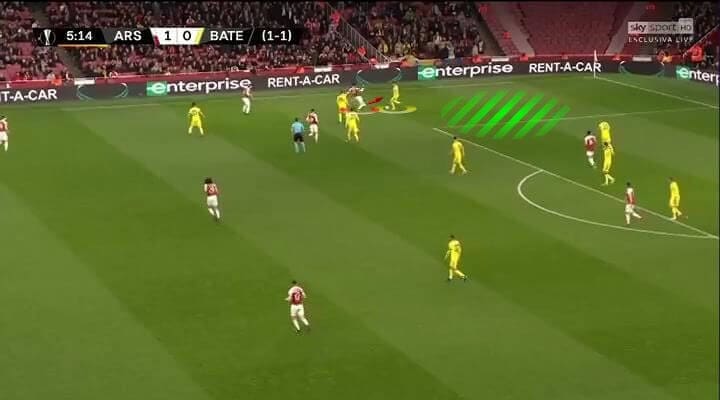
Having completed the recovery, Iwobi drives into the space behind the defender before firing a low cross towards the near post. The effort is cleared for a corner, but it shows how beneficial effective counter-pressing can be in creating dangerous opportunities.
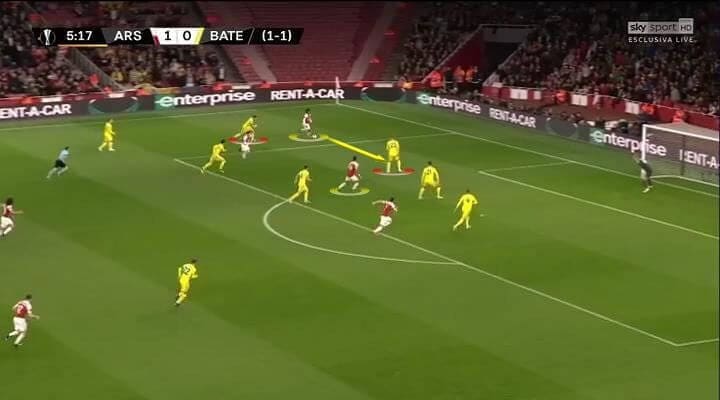
Overall, Iwobi has consistently shown a capacity to support his team during the defensive phases. The examples shown in this analysis, as well as the statistics, provide further indication that a positional change to a central role next season could prove beneficial.
With the lack of pace in Arsenal’s midfield, they are more vulnerable than most sides when it comes to defensive transitions. The recovery defending displayed in both fixtures against West Ham last term suggests that the AFCON star could play a part in reducing this issue.
What’s missing?
Perhaps the most frequent criticism leveled at Iwobi, his lack of composure in front of goal continues to leave fans somewhat frustrated. However, there have been signs of steady improvement under Emery.
In 2017/18, he scored three goals for Arsenal in all competitions, having struck four times in the previous campaign. Last season saw him find the back of the net on six occasions. Meanwhile, he also grabbed the winner in Nigeria’s recent African Cup of Nations victory over Cameroon, securing his country’s place in the quarter-finals.
Although the numbers highlight marginal progress in this area of his game, there is still plenty of room for improvement. He attempted 1.54 shots per 90 over the past 12 months, only hitting the target 40.4% of the time. Furthermore, many of those efforts were straight at the ‘keeper.
The following examples illustrate this issue. Having scored from a deflected strike earlier in the game, Iwobi is again fed through on goal by Mkhitaryan. He has a clear gap at the near post to exploit but instead fires his shot into the chest of Huddersfield’s Ben Hamer for a relatively easy save.
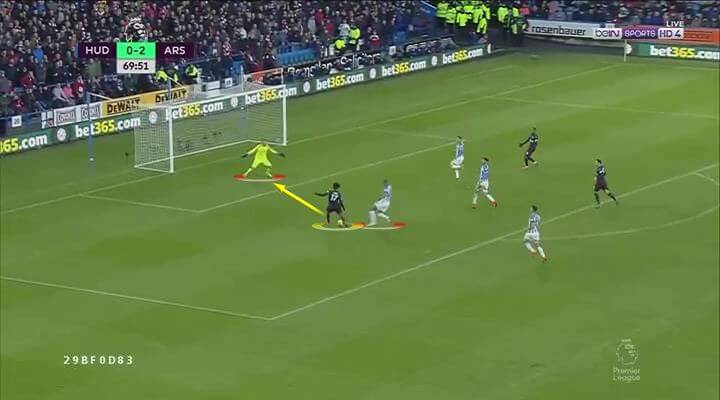
The next example emphasizes this weakness. With Arsenal edging closer to a damaging loss against Crystal Palace, Guendouzi lays the ball off for Iwobi just inside the penalty area. The path to goal is clear, but his strike is too close to Vicente Guaita between the sticks.
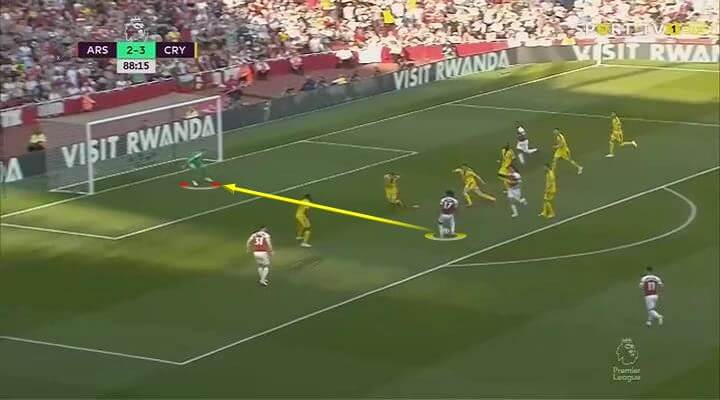
As stated, Iwobi has enjoyed a lot more fortune in front of goal when representing Nigeria. In their encounter with Cameroon last week, he occupied the number 10 role. Along with being chief creator, he was also expected to make late runs beyond the opponent’s back line.
His crucial goal, illustrated below, came after he noticed a gap emerge in the Cameroonian defence. Striker Odion Ighalo had moved away from the centre with the ball at his feet, dragging the opposing left centre-back out of the space. Iwobi arrives late to receive a through ball from the former Watford man.
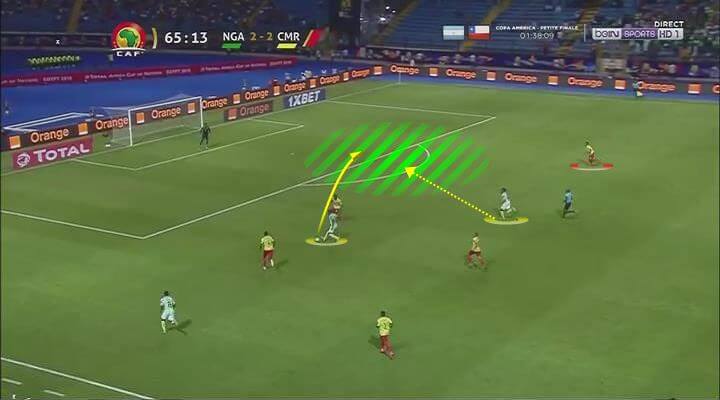
Having taken on possession inside the penalty area, he calmly finishes the move off with an excellent strike past Ajax’ prodigious ‘keeper Andre Onana. It was the type of chance that he so often fails to take in Arsenal colours, but perhaps that will change next season.
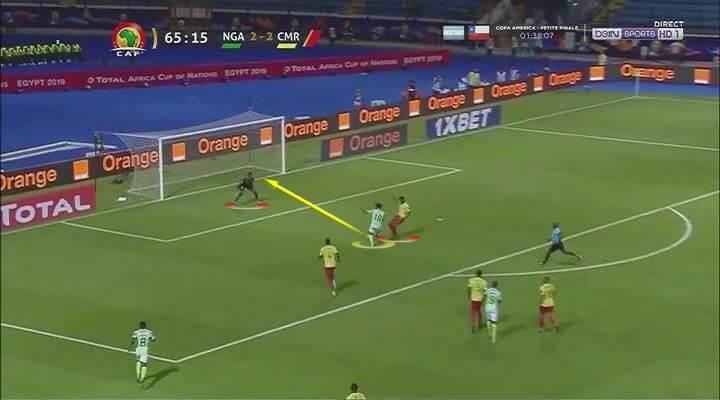
Iwobi’s substitute performance against Chelsea in the Europa League final also showed his vast potential. Along with creating three big chances for his teammates, he managed to score their only goal on the night.
With the Gunner’s 3-0 down and just over 20 minutes remaining, the ball falls to Iwobi on the edge of a congested penalty area. He executes the strike perfectly, volleying over the crowd and beyond Kepa.
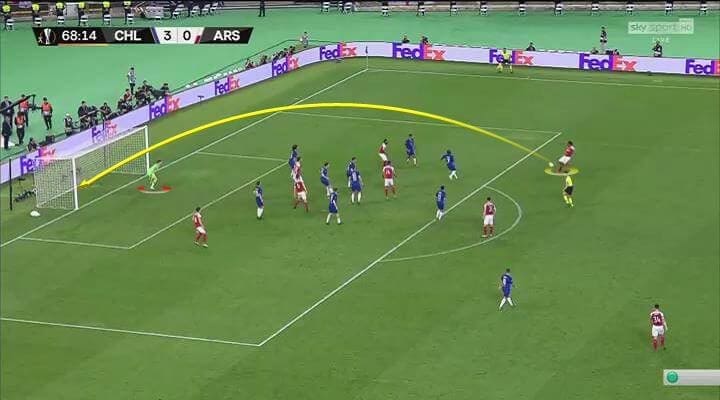
Both for club and country, Iwobi has shown some goalscoring potential during the last year. However, as detailed by the shot map in the first section of this scout report, his lack of productivity in terms of shots, expected goals, and actual goals are currently preventing him from becoming a more complete attacking outlet.
Conclusion
Overall, last season represented progress for Alex Iwobi. His creativity formed an important part of Arsenal’s attacks, while his commitment without the ball provided some much-needed support during the defensive phases.
As the new campaign approaches, he will be hoping that Emery trusts him with a more regular place in the starting XI. Additionally, a slight change of position might help to make better use of his varied talents. Should Iwobi emerge as a crucial player for the Gunner’s next term, he will give added hope and inspiration to the club’s long list of talented academy prospects.
If you love tactical analysis, then you’ll love the digital magazines from totalfootballanalysis.com – a guaranteed 100+ pages of pure tactical analysis covering topics from the Premier League, Serie A, La Liga, Bundesliga and many, many more. Buy your copy of the June issue for just ₤4.99 here, or even better sign up for a ₤50 annual membership (12 monthly issues plus the annual review) right here.

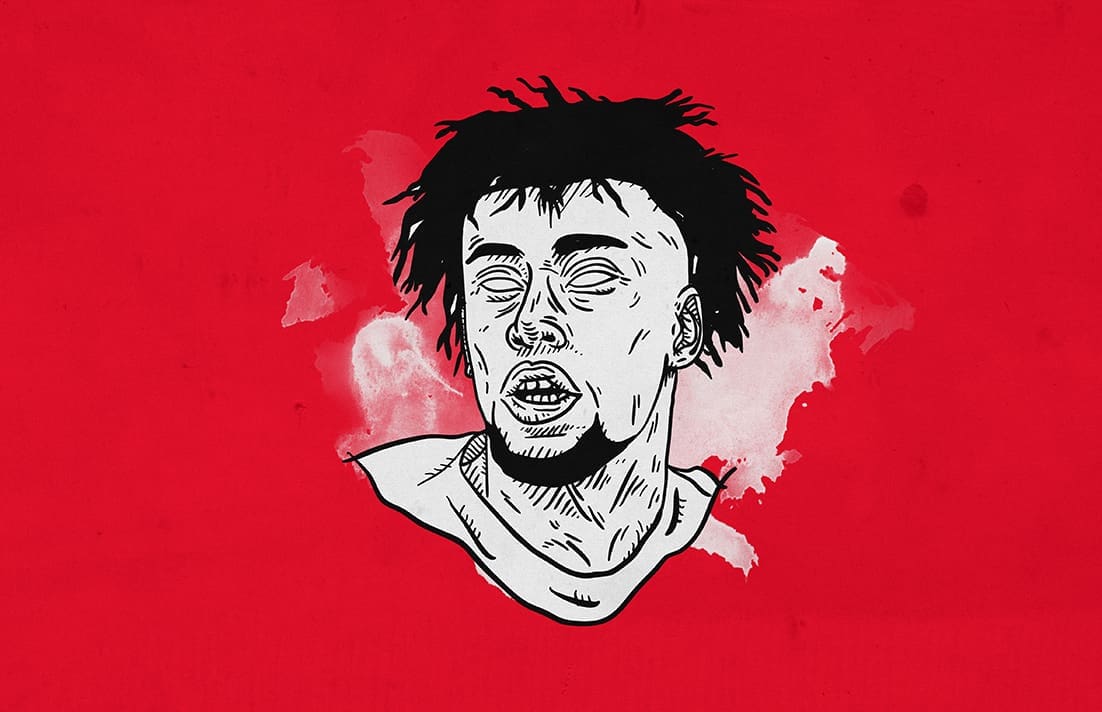




Comments